Economic Impact: Free Trade, Climate Change, and Global Governance
VerifiedAdded on 2022/08/24
|15
|3635
|25
Report
AI Summary
This report delves into the multifaceted relationship between free trade, climate change, and global economic governance. It begins by defining free trade and trade liberalism, outlining their benefits such as increased economic growth, consumer surplus, and technological transfer, while also acknowledging the effects of trade restrictions. The analysis then shifts to climate change, highlighting its challenges to global economic governance and its significant impact on economic costs, including the effects on production, GDP, and various industries. The report uses production functions and supply-demand models to illustrate the economic consequences of climate change, such as decreased output and rising prices. The report also explores the interrelationship between climate change, extreme weather events, and the need for sustainable economic practices. Overall, the report provides a comprehensive overview of the economic implications of these interconnected global issues.

Running head: GLOBAL ECONOMY
GLOBAL ECONOMY
Name of Student:
Name of University:
Author Note:
GLOBAL ECONOMY
Name of Student:
Name of University:
Author Note:
Paraphrase This Document
Need a fresh take? Get an instant paraphrase of this document with our AI Paraphraser
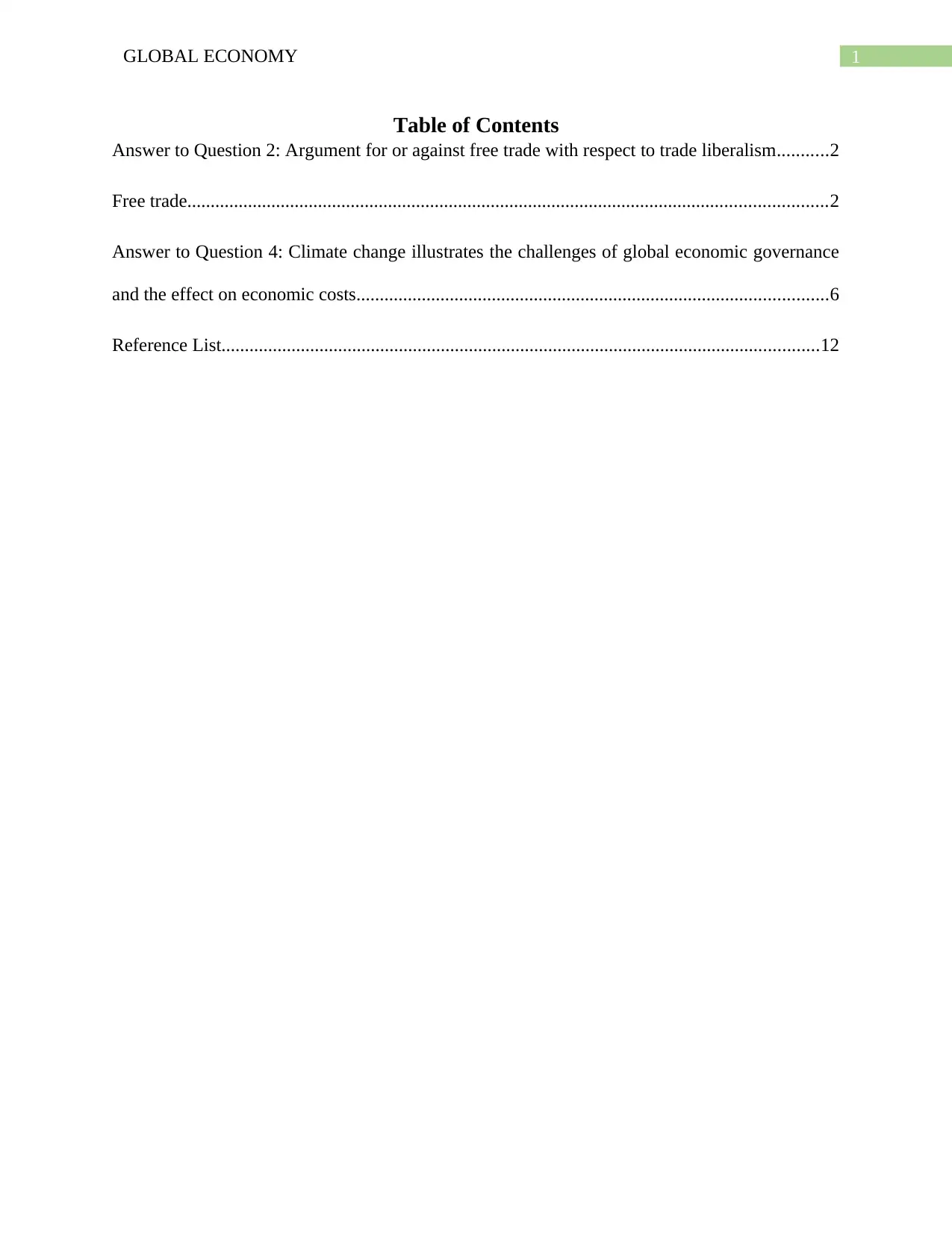
1GLOBAL ECONOMY
Table of Contents
Answer to Question 2: Argument for or against free trade with respect to trade liberalism...........2
Free trade.........................................................................................................................................2
Answer to Question 4: Climate change illustrates the challenges of global economic governance
and the effect on economic costs.....................................................................................................6
Reference List................................................................................................................................12
Table of Contents
Answer to Question 2: Argument for or against free trade with respect to trade liberalism...........2
Free trade.........................................................................................................................................2
Answer to Question 4: Climate change illustrates the challenges of global economic governance
and the effect on economic costs.....................................................................................................6
Reference List................................................................................................................................12
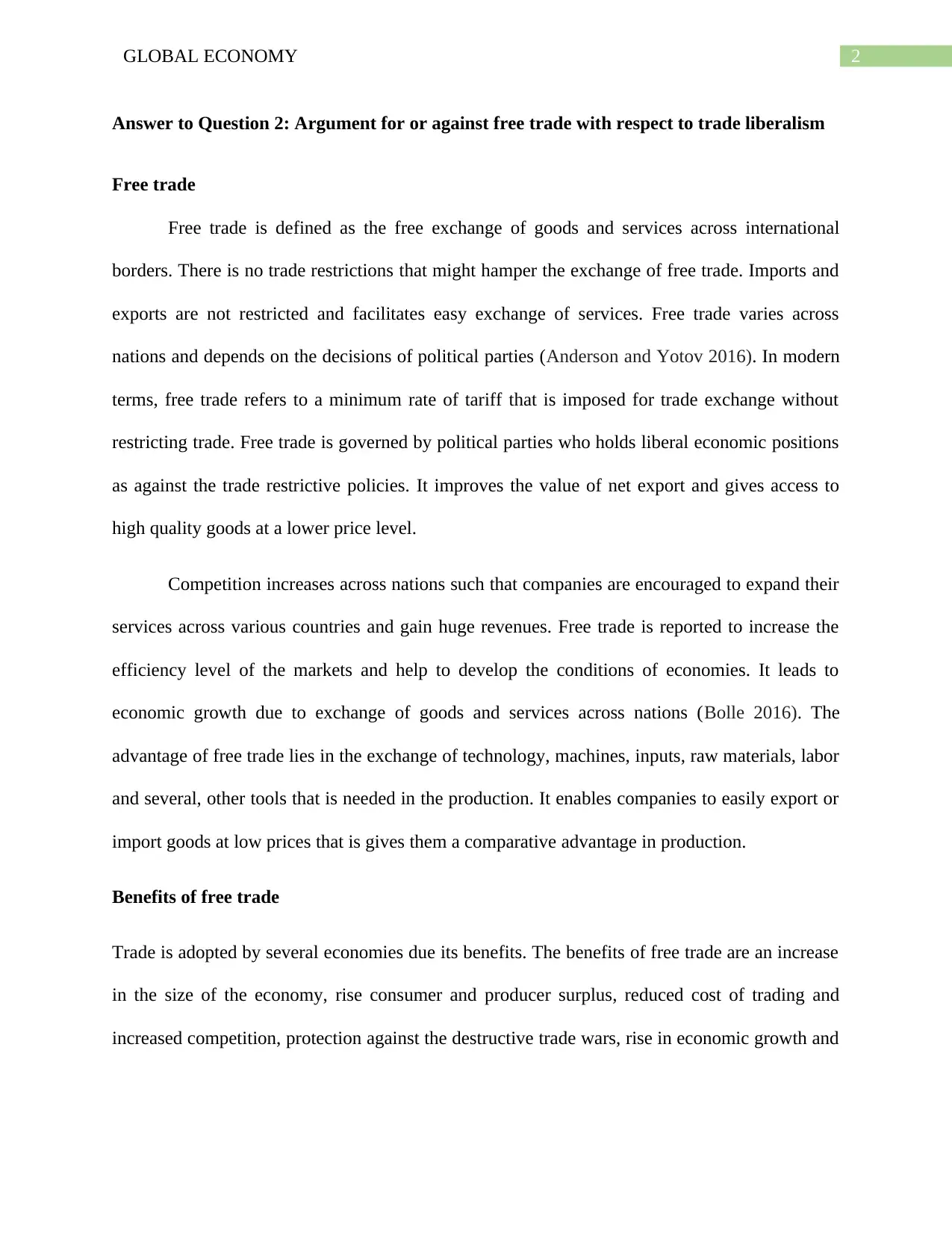
2GLOBAL ECONOMY
Answer to Question 2: Argument for or against free trade with respect to trade liberalism
Free trade
Free trade is defined as the free exchange of goods and services across international
borders. There is no trade restrictions that might hamper the exchange of free trade. Imports and
exports are not restricted and facilitates easy exchange of services. Free trade varies across
nations and depends on the decisions of political parties (Anderson and Yotov 2016). In modern
terms, free trade refers to a minimum rate of tariff that is imposed for trade exchange without
restricting trade. Free trade is governed by political parties who holds liberal economic positions
as against the trade restrictive policies. It improves the value of net export and gives access to
high quality goods at a lower price level.
Competition increases across nations such that companies are encouraged to expand their
services across various countries and gain huge revenues. Free trade is reported to increase the
efficiency level of the markets and help to develop the conditions of economies. It leads to
economic growth due to exchange of goods and services across nations (Bolle 2016). The
advantage of free trade lies in the exchange of technology, machines, inputs, raw materials, labor
and several, other tools that is needed in the production. It enables companies to easily export or
import goods at low prices that is gives them a comparative advantage in production.
Benefits of free trade
Trade is adopted by several economies due its benefits. The benefits of free trade are an increase
in the size of the economy, rise consumer and producer surplus, reduced cost of trading and
increased competition, protection against the destructive trade wars, rise in economic growth and
Answer to Question 2: Argument for or against free trade with respect to trade liberalism
Free trade
Free trade is defined as the free exchange of goods and services across international
borders. There is no trade restrictions that might hamper the exchange of free trade. Imports and
exports are not restricted and facilitates easy exchange of services. Free trade varies across
nations and depends on the decisions of political parties (Anderson and Yotov 2016). In modern
terms, free trade refers to a minimum rate of tariff that is imposed for trade exchange without
restricting trade. Free trade is governed by political parties who holds liberal economic positions
as against the trade restrictive policies. It improves the value of net export and gives access to
high quality goods at a lower price level.
Competition increases across nations such that companies are encouraged to expand their
services across various countries and gain huge revenues. Free trade is reported to increase the
efficiency level of the markets and help to develop the conditions of economies. It leads to
economic growth due to exchange of goods and services across nations (Bolle 2016). The
advantage of free trade lies in the exchange of technology, machines, inputs, raw materials, labor
and several, other tools that is needed in the production. It enables companies to easily export or
import goods at low prices that is gives them a comparative advantage in production.
Benefits of free trade
Trade is adopted by several economies due its benefits. The benefits of free trade are an increase
in the size of the economy, rise consumer and producer surplus, reduced cost of trading and
increased competition, protection against the destructive trade wars, rise in economic growth and
⊘ This is a preview!⊘
Do you want full access?
Subscribe today to unlock all pages.

Trusted by 1+ million students worldwide
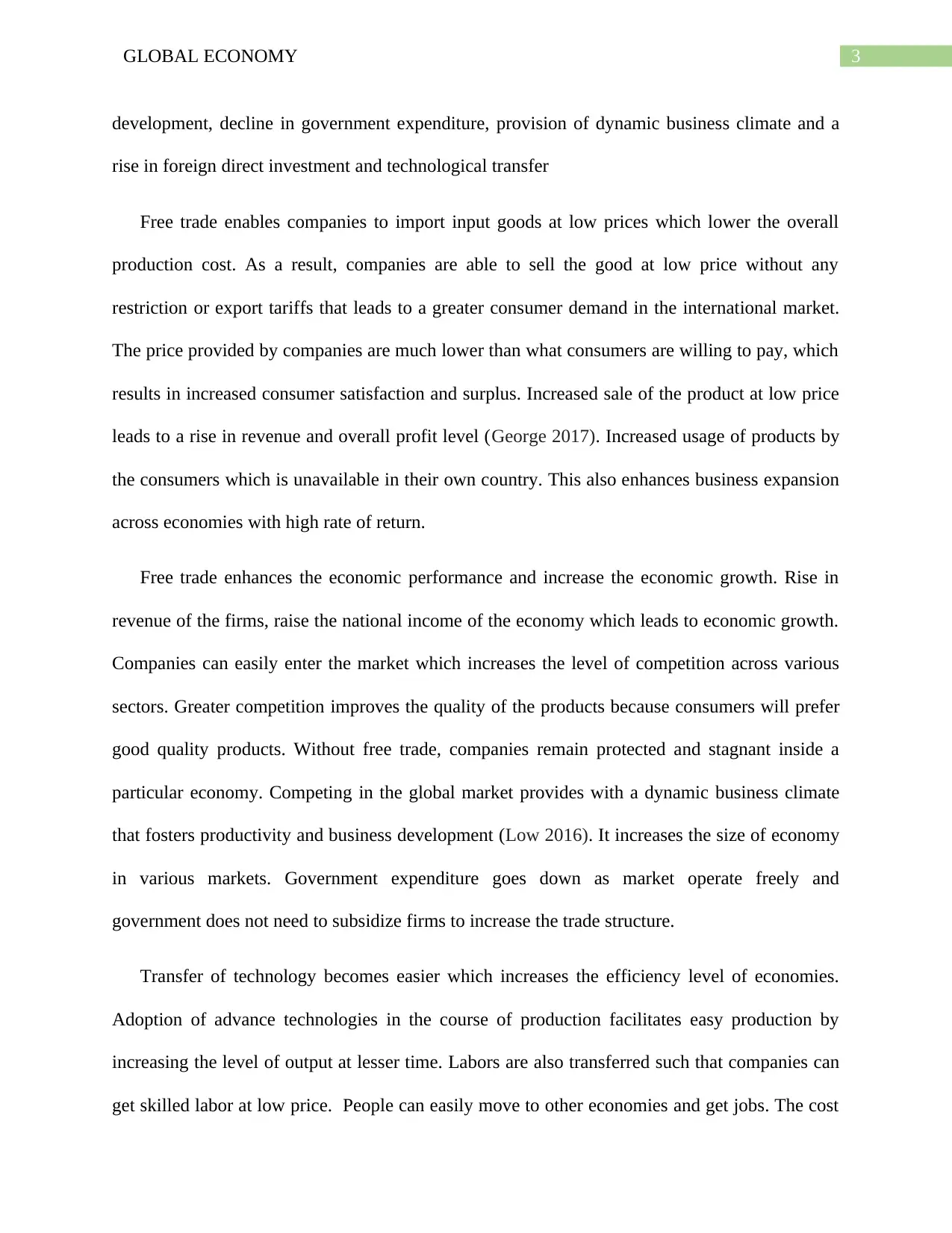
3GLOBAL ECONOMY
development, decline in government expenditure, provision of dynamic business climate and a
rise in foreign direct investment and technological transfer
Free trade enables companies to import input goods at low prices which lower the overall
production cost. As a result, companies are able to sell the good at low price without any
restriction or export tariffs that leads to a greater consumer demand in the international market.
The price provided by companies are much lower than what consumers are willing to pay, which
results in increased consumer satisfaction and surplus. Increased sale of the product at low price
leads to a rise in revenue and overall profit level (George 2017). Increased usage of products by
the consumers which is unavailable in their own country. This also enhances business expansion
across economies with high rate of return.
Free trade enhances the economic performance and increase the economic growth. Rise in
revenue of the firms, raise the national income of the economy which leads to economic growth.
Companies can easily enter the market which increases the level of competition across various
sectors. Greater competition improves the quality of the products because consumers will prefer
good quality products. Without free trade, companies remain protected and stagnant inside a
particular economy. Competing in the global market provides with a dynamic business climate
that fosters productivity and business development (Low 2016). It increases the size of economy
in various markets. Government expenditure goes down as market operate freely and
government does not need to subsidize firms to increase the trade structure.
Transfer of technology becomes easier which increases the efficiency level of economies.
Adoption of advance technologies in the course of production facilitates easy production by
increasing the level of output at lesser time. Labors are also transferred such that companies can
get skilled labor at low price. People can easily move to other economies and get jobs. The cost
development, decline in government expenditure, provision of dynamic business climate and a
rise in foreign direct investment and technological transfer
Free trade enables companies to import input goods at low prices which lower the overall
production cost. As a result, companies are able to sell the good at low price without any
restriction or export tariffs that leads to a greater consumer demand in the international market.
The price provided by companies are much lower than what consumers are willing to pay, which
results in increased consumer satisfaction and surplus. Increased sale of the product at low price
leads to a rise in revenue and overall profit level (George 2017). Increased usage of products by
the consumers which is unavailable in their own country. This also enhances business expansion
across economies with high rate of return.
Free trade enhances the economic performance and increase the economic growth. Rise in
revenue of the firms, raise the national income of the economy which leads to economic growth.
Companies can easily enter the market which increases the level of competition across various
sectors. Greater competition improves the quality of the products because consumers will prefer
good quality products. Without free trade, companies remain protected and stagnant inside a
particular economy. Competing in the global market provides with a dynamic business climate
that fosters productivity and business development (Low 2016). It increases the size of economy
in various markets. Government expenditure goes down as market operate freely and
government does not need to subsidize firms to increase the trade structure.
Transfer of technology becomes easier which increases the efficiency level of economies.
Adoption of advance technologies in the course of production facilitates easy production by
increasing the level of output at lesser time. Labors are also transferred such that companies can
get skilled labor at low price. People can easily move to other economies and get jobs. The cost
Paraphrase This Document
Need a fresh take? Get an instant paraphrase of this document with our AI Paraphraser
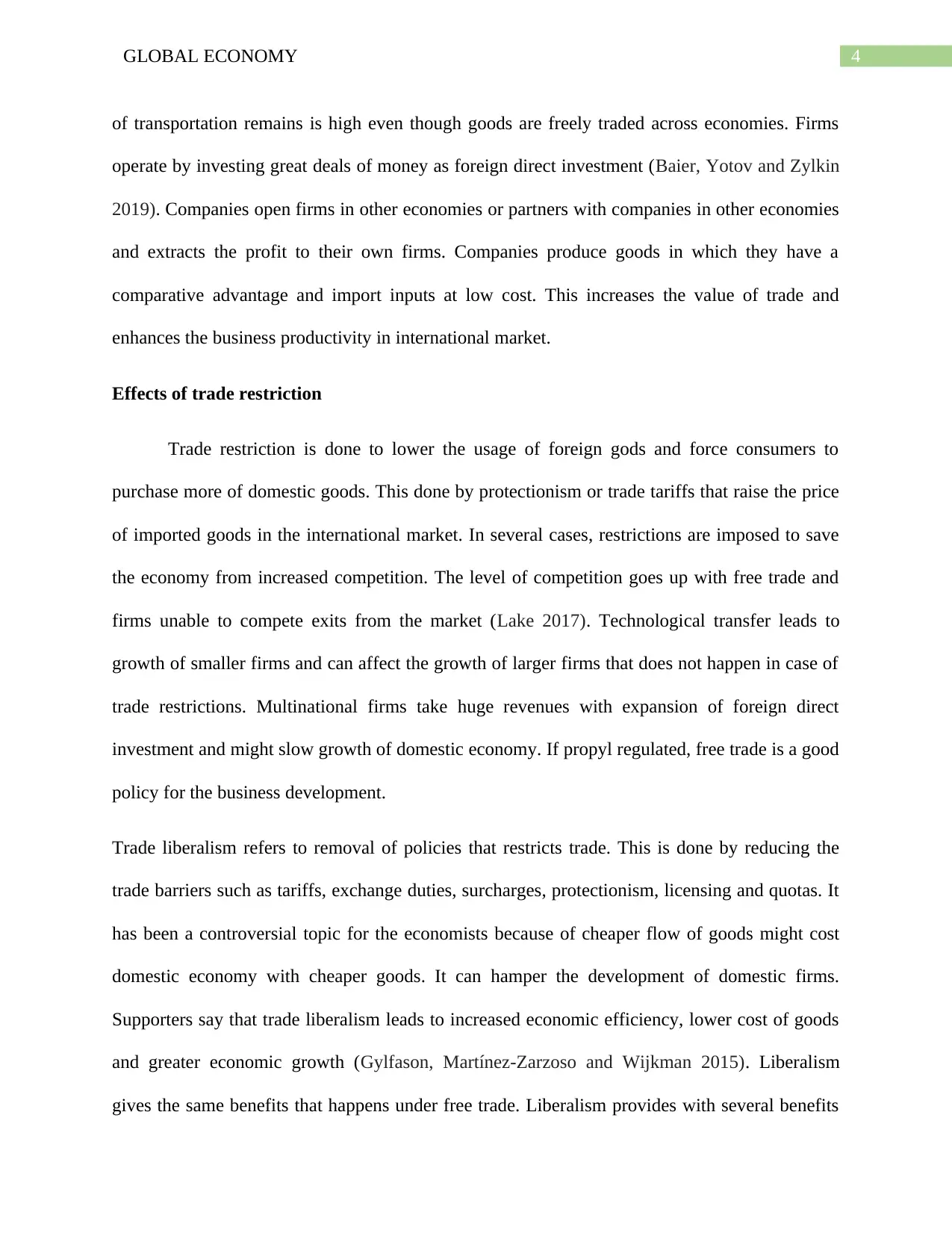
4GLOBAL ECONOMY
of transportation remains is high even though goods are freely traded across economies. Firms
operate by investing great deals of money as foreign direct investment (Baier, Yotov and Zylkin
2019). Companies open firms in other economies or partners with companies in other economies
and extracts the profit to their own firms. Companies produce goods in which they have a
comparative advantage and import inputs at low cost. This increases the value of trade and
enhances the business productivity in international market.
Effects of trade restriction
Trade restriction is done to lower the usage of foreign gods and force consumers to
purchase more of domestic goods. This done by protectionism or trade tariffs that raise the price
of imported goods in the international market. In several cases, restrictions are imposed to save
the economy from increased competition. The level of competition goes up with free trade and
firms unable to compete exits from the market (Lake 2017). Technological transfer leads to
growth of smaller firms and can affect the growth of larger firms that does not happen in case of
trade restrictions. Multinational firms take huge revenues with expansion of foreign direct
investment and might slow growth of domestic economy. If propyl regulated, free trade is a good
policy for the business development.
Trade liberalism refers to removal of policies that restricts trade. This is done by reducing the
trade barriers such as tariffs, exchange duties, surcharges, protectionism, licensing and quotas. It
has been a controversial topic for the economists because of cheaper flow of goods might cost
domestic economy with cheaper goods. It can hamper the development of domestic firms.
Supporters say that trade liberalism leads to increased economic efficiency, lower cost of goods
and greater economic growth (Gylfason, Martínez‐Zarzoso and Wijkman 2015). Liberalism
gives the same benefits that happens under free trade. Liberalism provides with several benefits
of transportation remains is high even though goods are freely traded across economies. Firms
operate by investing great deals of money as foreign direct investment (Baier, Yotov and Zylkin
2019). Companies open firms in other economies or partners with companies in other economies
and extracts the profit to their own firms. Companies produce goods in which they have a
comparative advantage and import inputs at low cost. This increases the value of trade and
enhances the business productivity in international market.
Effects of trade restriction
Trade restriction is done to lower the usage of foreign gods and force consumers to
purchase more of domestic goods. This done by protectionism or trade tariffs that raise the price
of imported goods in the international market. In several cases, restrictions are imposed to save
the economy from increased competition. The level of competition goes up with free trade and
firms unable to compete exits from the market (Lake 2017). Technological transfer leads to
growth of smaller firms and can affect the growth of larger firms that does not happen in case of
trade restrictions. Multinational firms take huge revenues with expansion of foreign direct
investment and might slow growth of domestic economy. If propyl regulated, free trade is a good
policy for the business development.
Trade liberalism refers to removal of policies that restricts trade. This is done by reducing the
trade barriers such as tariffs, exchange duties, surcharges, protectionism, licensing and quotas. It
has been a controversial topic for the economists because of cheaper flow of goods might cost
domestic economy with cheaper goods. It can hamper the development of domestic firms.
Supporters say that trade liberalism leads to increased economic efficiency, lower cost of goods
and greater economic growth (Gylfason, Martínez‐Zarzoso and Wijkman 2015). Liberalism
gives the same benefits that happens under free trade. Liberalism provides with several benefits
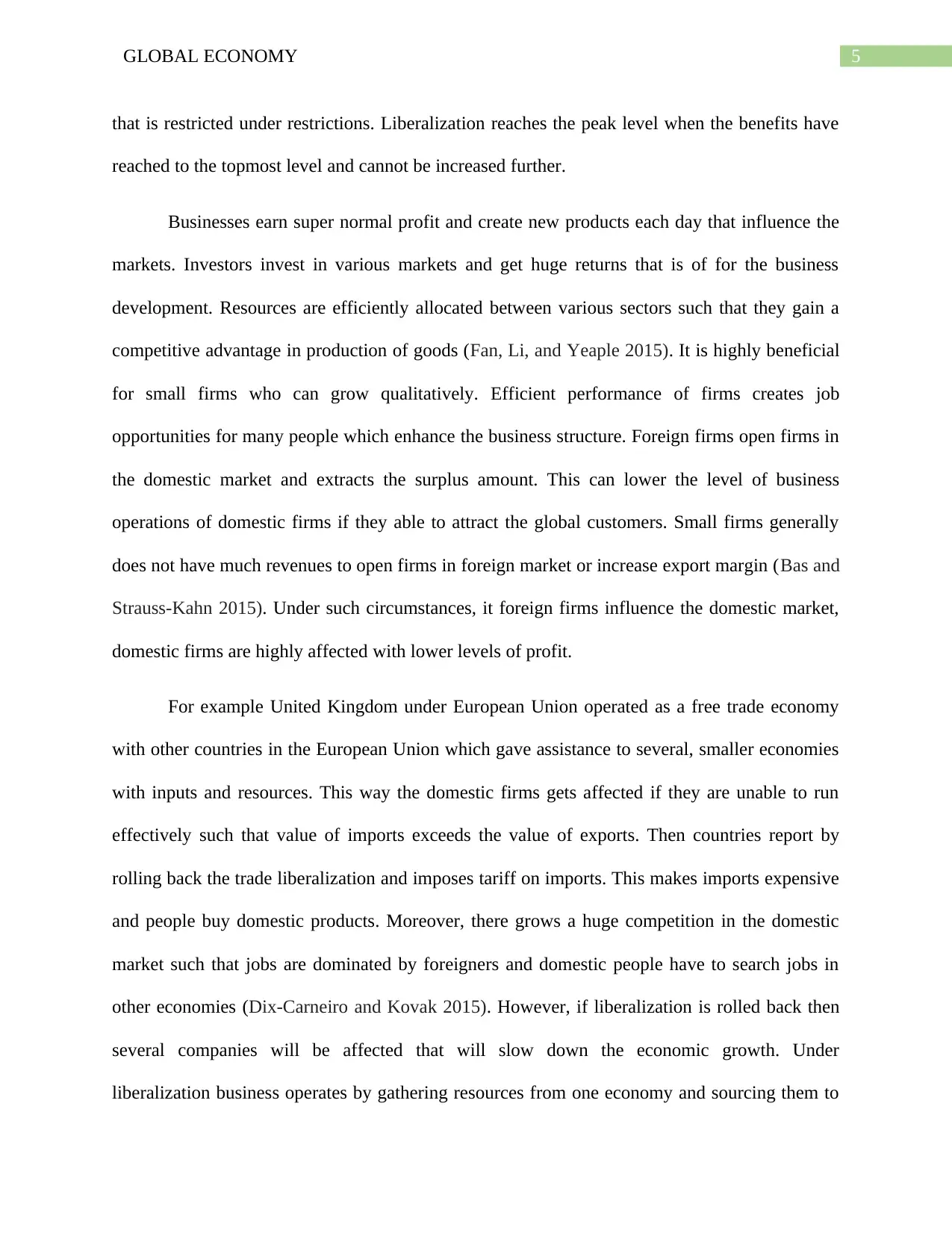
5GLOBAL ECONOMY
that is restricted under restrictions. Liberalization reaches the peak level when the benefits have
reached to the topmost level and cannot be increased further.
Businesses earn super normal profit and create new products each day that influence the
markets. Investors invest in various markets and get huge returns that is of for the business
development. Resources are efficiently allocated between various sectors such that they gain a
competitive advantage in production of goods (Fan, Li, and Yeaple 2015). It is highly beneficial
for small firms who can grow qualitatively. Efficient performance of firms creates job
opportunities for many people which enhance the business structure. Foreign firms open firms in
the domestic market and extracts the surplus amount. This can lower the level of business
operations of domestic firms if they able to attract the global customers. Small firms generally
does not have much revenues to open firms in foreign market or increase export margin (Bas and
Strauss-Kahn 2015). Under such circumstances, it foreign firms influence the domestic market,
domestic firms are highly affected with lower levels of profit.
For example United Kingdom under European Union operated as a free trade economy
with other countries in the European Union which gave assistance to several, smaller economies
with inputs and resources. This way the domestic firms gets affected if they are unable to run
effectively such that value of imports exceeds the value of exports. Then countries report by
rolling back the trade liberalization and imposes tariff on imports. This makes imports expensive
and people buy domestic products. Moreover, there grows a huge competition in the domestic
market such that jobs are dominated by foreigners and domestic people have to search jobs in
other economies (Dix-Carneiro and Kovak 2015). However, if liberalization is rolled back then
several companies will be affected that will slow down the economic growth. Under
liberalization business operates by gathering resources from one economy and sourcing them to
that is restricted under restrictions. Liberalization reaches the peak level when the benefits have
reached to the topmost level and cannot be increased further.
Businesses earn super normal profit and create new products each day that influence the
markets. Investors invest in various markets and get huge returns that is of for the business
development. Resources are efficiently allocated between various sectors such that they gain a
competitive advantage in production of goods (Fan, Li, and Yeaple 2015). It is highly beneficial
for small firms who can grow qualitatively. Efficient performance of firms creates job
opportunities for many people which enhance the business structure. Foreign firms open firms in
the domestic market and extracts the surplus amount. This can lower the level of business
operations of domestic firms if they able to attract the global customers. Small firms generally
does not have much revenues to open firms in foreign market or increase export margin (Bas and
Strauss-Kahn 2015). Under such circumstances, it foreign firms influence the domestic market,
domestic firms are highly affected with lower levels of profit.
For example United Kingdom under European Union operated as a free trade economy
with other countries in the European Union which gave assistance to several, smaller economies
with inputs and resources. This way the domestic firms gets affected if they are unable to run
effectively such that value of imports exceeds the value of exports. Then countries report by
rolling back the trade liberalization and imposes tariff on imports. This makes imports expensive
and people buy domestic products. Moreover, there grows a huge competition in the domestic
market such that jobs are dominated by foreigners and domestic people have to search jobs in
other economies (Dix-Carneiro and Kovak 2015). However, if liberalization is rolled back then
several companies will be affected that will slow down the economic growth. Under
liberalization business operates by gathering resources from one economy and sourcing them to
⊘ This is a preview!⊘
Do you want full access?
Subscribe today to unlock all pages.

Trusted by 1+ million students worldwide
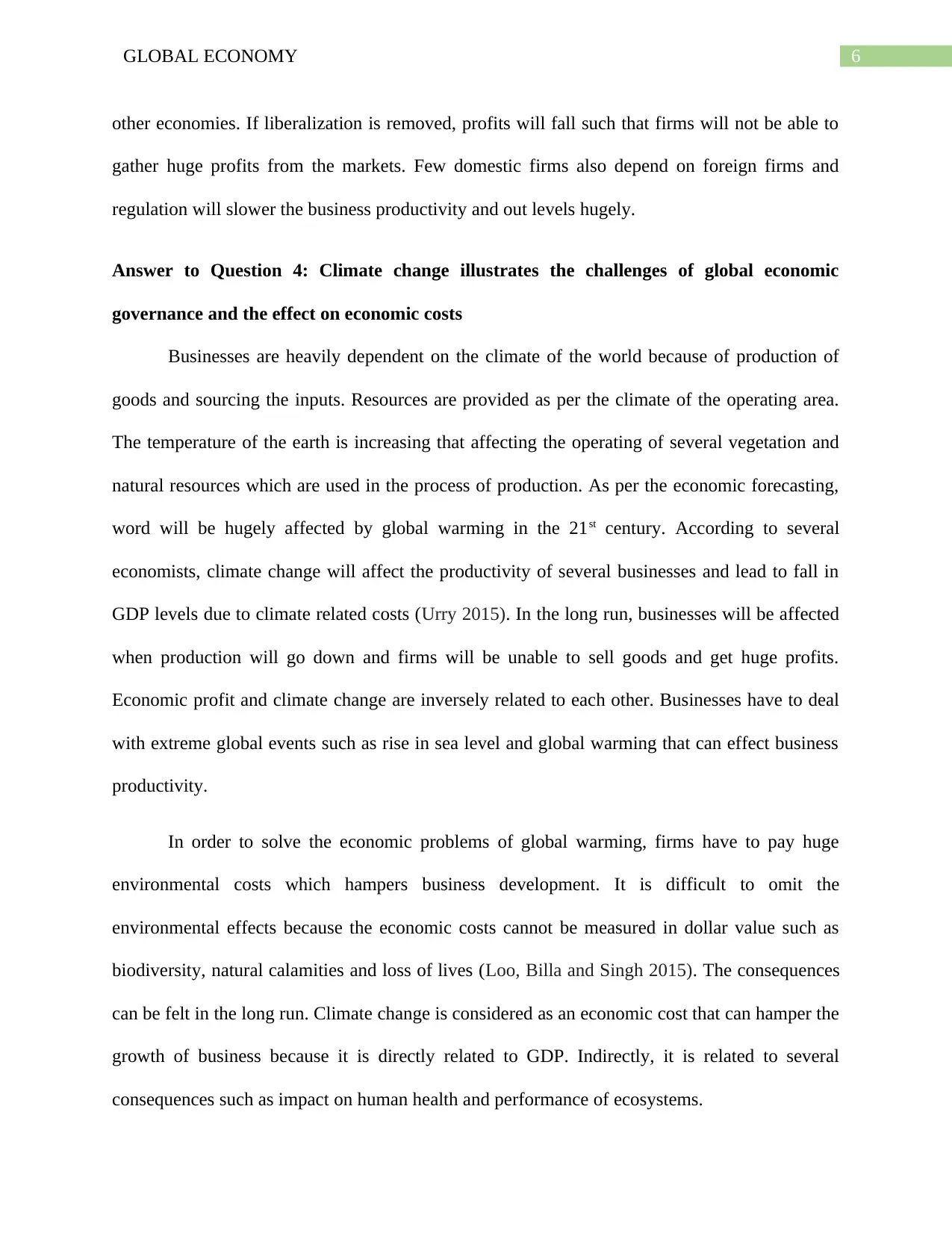
6GLOBAL ECONOMY
other economies. If liberalization is removed, profits will fall such that firms will not be able to
gather huge profits from the markets. Few domestic firms also depend on foreign firms and
regulation will slower the business productivity and out levels hugely.
Answer to Question 4: Climate change illustrates the challenges of global economic
governance and the effect on economic costs
Businesses are heavily dependent on the climate of the world because of production of
goods and sourcing the inputs. Resources are provided as per the climate of the operating area.
The temperature of the earth is increasing that affecting the operating of several vegetation and
natural resources which are used in the process of production. As per the economic forecasting,
word will be hugely affected by global warming in the 21st century. According to several
economists, climate change will affect the productivity of several businesses and lead to fall in
GDP levels due to climate related costs (Urry 2015). In the long run, businesses will be affected
when production will go down and firms will be unable to sell goods and get huge profits.
Economic profit and climate change are inversely related to each other. Businesses have to deal
with extreme global events such as rise in sea level and global warming that can effect business
productivity.
In order to solve the economic problems of global warming, firms have to pay huge
environmental costs which hampers business development. It is difficult to omit the
environmental effects because the economic costs cannot be measured in dollar value such as
biodiversity, natural calamities and loss of lives (Loo, Billa and Singh 2015). The consequences
can be felt in the long run. Climate change is considered as an economic cost that can hamper the
growth of business because it is directly related to GDP. Indirectly, it is related to several
consequences such as impact on human health and performance of ecosystems.
other economies. If liberalization is removed, profits will fall such that firms will not be able to
gather huge profits from the markets. Few domestic firms also depend on foreign firms and
regulation will slower the business productivity and out levels hugely.
Answer to Question 4: Climate change illustrates the challenges of global economic
governance and the effect on economic costs
Businesses are heavily dependent on the climate of the world because of production of
goods and sourcing the inputs. Resources are provided as per the climate of the operating area.
The temperature of the earth is increasing that affecting the operating of several vegetation and
natural resources which are used in the process of production. As per the economic forecasting,
word will be hugely affected by global warming in the 21st century. According to several
economists, climate change will affect the productivity of several businesses and lead to fall in
GDP levels due to climate related costs (Urry 2015). In the long run, businesses will be affected
when production will go down and firms will be unable to sell goods and get huge profits.
Economic profit and climate change are inversely related to each other. Businesses have to deal
with extreme global events such as rise in sea level and global warming that can effect business
productivity.
In order to solve the economic problems of global warming, firms have to pay huge
environmental costs which hampers business development. It is difficult to omit the
environmental effects because the economic costs cannot be measured in dollar value such as
biodiversity, natural calamities and loss of lives (Loo, Billa and Singh 2015). The consequences
can be felt in the long run. Climate change is considered as an economic cost that can hamper the
growth of business because it is directly related to GDP. Indirectly, it is related to several
consequences such as impact on human health and performance of ecosystems.
Paraphrase This Document
Need a fresh take? Get an instant paraphrase of this document with our AI Paraphraser
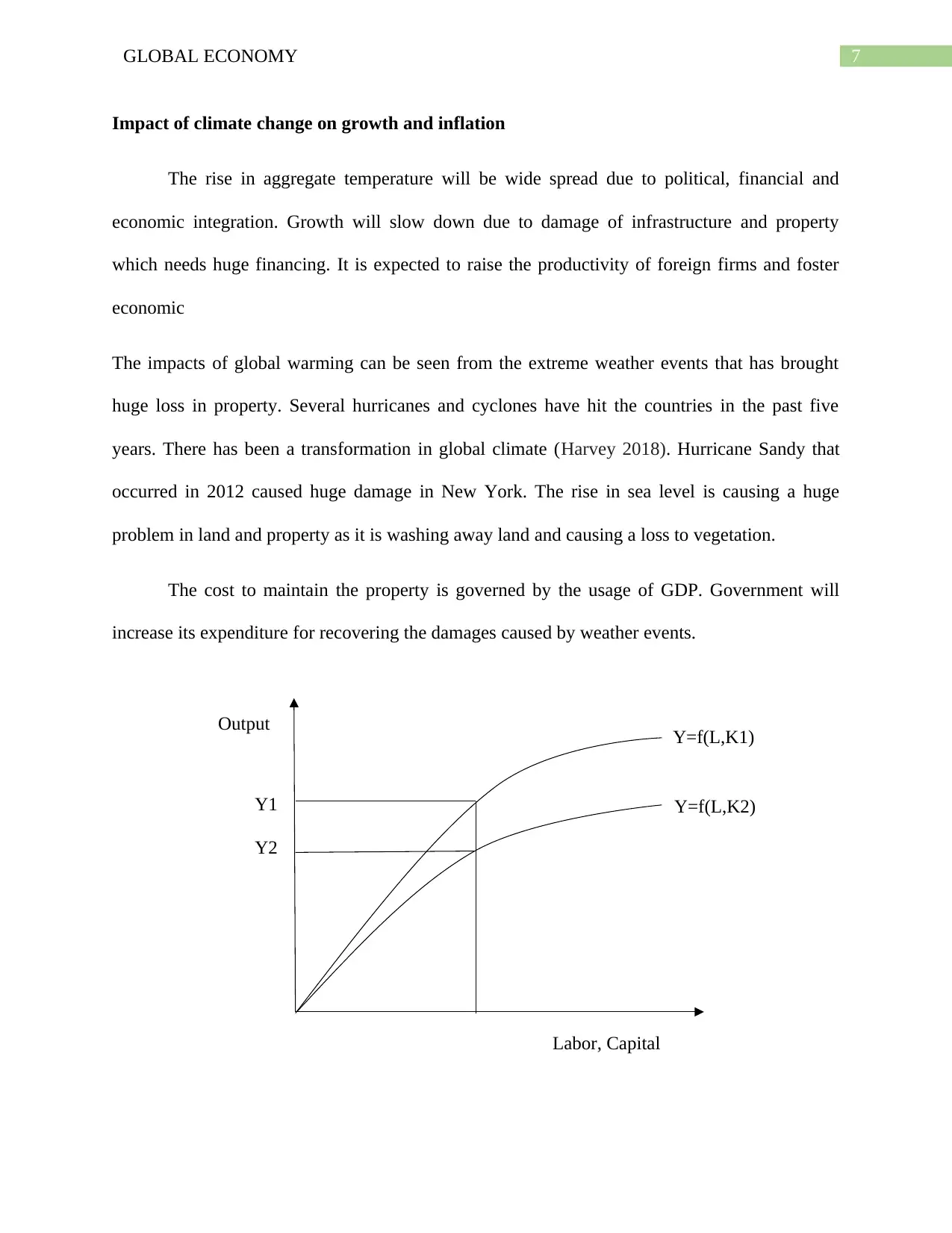
7GLOBAL ECONOMY
Y=f(L,K1)
Y=f(L,K2)Y1
Y2
Labor, Capital
Output
Impact of climate change on growth and inflation
The rise in aggregate temperature will be wide spread due to political, financial and
economic integration. Growth will slow down due to damage of infrastructure and property
which needs huge financing. It is expected to raise the productivity of foreign firms and foster
economic
The impacts of global warming can be seen from the extreme weather events that has brought
huge loss in property. Several hurricanes and cyclones have hit the countries in the past five
years. There has been a transformation in global climate (Harvey 2018). Hurricane Sandy that
occurred in 2012 caused huge damage in New York. The rise in sea level is causing a huge
problem in land and property as it is washing away land and causing a loss to vegetation.
The cost to maintain the property is governed by the usage of GDP. Government will
increase its expenditure for recovering the damages caused by weather events.
Y=f(L,K1)
Y=f(L,K2)Y1
Y2
Labor, Capital
Output
Impact of climate change on growth and inflation
The rise in aggregate temperature will be wide spread due to political, financial and
economic integration. Growth will slow down due to damage of infrastructure and property
which needs huge financing. It is expected to raise the productivity of foreign firms and foster
economic
The impacts of global warming can be seen from the extreme weather events that has brought
huge loss in property. Several hurricanes and cyclones have hit the countries in the past five
years. There has been a transformation in global climate (Harvey 2018). Hurricane Sandy that
occurred in 2012 caused huge damage in New York. The rise in sea level is causing a huge
problem in land and property as it is washing away land and causing a loss to vegetation.
The cost to maintain the property is governed by the usage of GDP. Government will
increase its expenditure for recovering the damages caused by weather events.
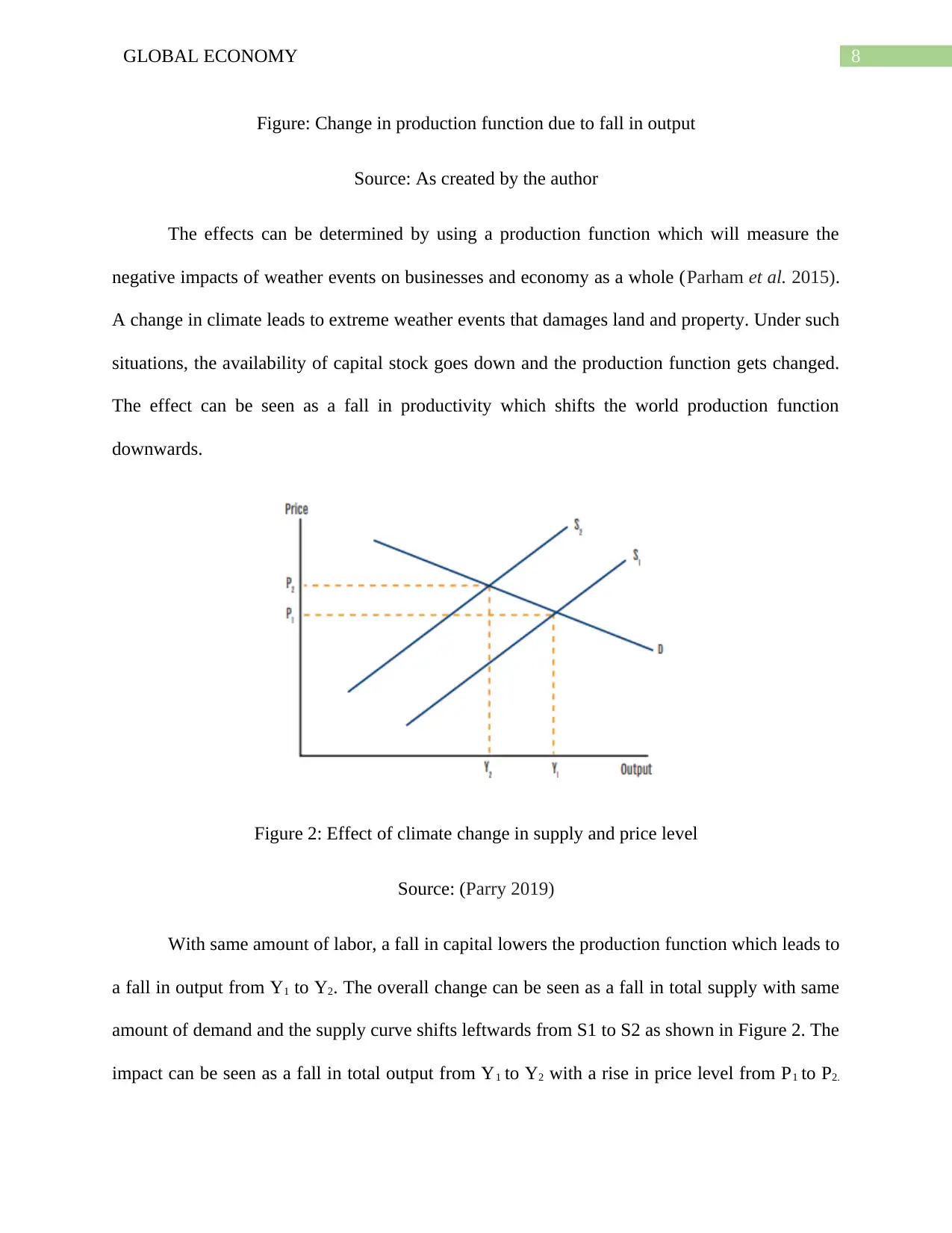
8GLOBAL ECONOMY
Figure: Change in production function due to fall in output
Source: As created by the author
The effects can be determined by using a production function which will measure the
negative impacts of weather events on businesses and economy as a whole (Parham et al. 2015).
A change in climate leads to extreme weather events that damages land and property. Under such
situations, the availability of capital stock goes down and the production function gets changed.
The effect can be seen as a fall in productivity which shifts the world production function
downwards.
Figure 2: Effect of climate change in supply and price level
Source: (Parry 2019)
With same amount of labor, a fall in capital lowers the production function which leads to
a fall in output from Y1 to Y2. The overall change can be seen as a fall in total supply with same
amount of demand and the supply curve shifts leftwards from S1 to S2 as shown in Figure 2. The
impact can be seen as a fall in total output from Y1 to Y2 with a rise in price level from P1 to P2.
Figure: Change in production function due to fall in output
Source: As created by the author
The effects can be determined by using a production function which will measure the
negative impacts of weather events on businesses and economy as a whole (Parham et al. 2015).
A change in climate leads to extreme weather events that damages land and property. Under such
situations, the availability of capital stock goes down and the production function gets changed.
The effect can be seen as a fall in productivity which shifts the world production function
downwards.
Figure 2: Effect of climate change in supply and price level
Source: (Parry 2019)
With same amount of labor, a fall in capital lowers the production function which leads to
a fall in output from Y1 to Y2. The overall change can be seen as a fall in total supply with same
amount of demand and the supply curve shifts leftwards from S1 to S2 as shown in Figure 2. The
impact can be seen as a fall in total output from Y1 to Y2 with a rise in price level from P1 to P2.
⊘ This is a preview!⊘
Do you want full access?
Subscribe today to unlock all pages.

Trusted by 1+ million students worldwide
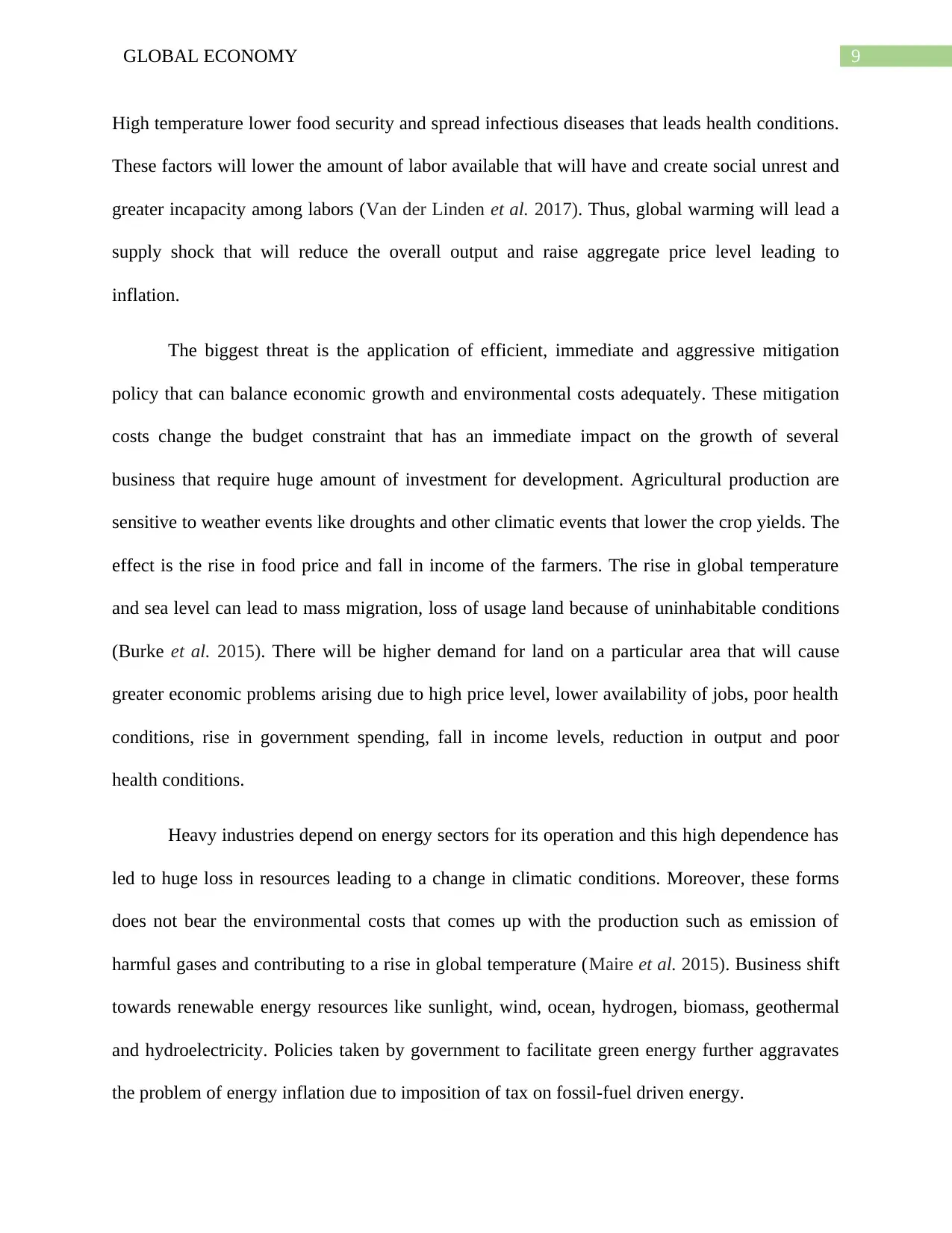
9GLOBAL ECONOMY
High temperature lower food security and spread infectious diseases that leads health conditions.
These factors will lower the amount of labor available that will have and create social unrest and
greater incapacity among labors (Van der Linden et al. 2017). Thus, global warming will lead a
supply shock that will reduce the overall output and raise aggregate price level leading to
inflation.
The biggest threat is the application of efficient, immediate and aggressive mitigation
policy that can balance economic growth and environmental costs adequately. These mitigation
costs change the budget constraint that has an immediate impact on the growth of several
business that require huge amount of investment for development. Agricultural production are
sensitive to weather events like droughts and other climatic events that lower the crop yields. The
effect is the rise in food price and fall in income of the farmers. The rise in global temperature
and sea level can lead to mass migration, loss of usage land because of uninhabitable conditions
(Burke et al. 2015). There will be higher demand for land on a particular area that will cause
greater economic problems arising due to high price level, lower availability of jobs, poor health
conditions, rise in government spending, fall in income levels, reduction in output and poor
health conditions.
Heavy industries depend on energy sectors for its operation and this high dependence has
led to huge loss in resources leading to a change in climatic conditions. Moreover, these forms
does not bear the environmental costs that comes up with the production such as emission of
harmful gases and contributing to a rise in global temperature (Maire et al. 2015). Business shift
towards renewable energy resources like sunlight, wind, ocean, hydrogen, biomass, geothermal
and hydroelectricity. Policies taken by government to facilitate green energy further aggravates
the problem of energy inflation due to imposition of tax on fossil-fuel driven energy.
High temperature lower food security and spread infectious diseases that leads health conditions.
These factors will lower the amount of labor available that will have and create social unrest and
greater incapacity among labors (Van der Linden et al. 2017). Thus, global warming will lead a
supply shock that will reduce the overall output and raise aggregate price level leading to
inflation.
The biggest threat is the application of efficient, immediate and aggressive mitigation
policy that can balance economic growth and environmental costs adequately. These mitigation
costs change the budget constraint that has an immediate impact on the growth of several
business that require huge amount of investment for development. Agricultural production are
sensitive to weather events like droughts and other climatic events that lower the crop yields. The
effect is the rise in food price and fall in income of the farmers. The rise in global temperature
and sea level can lead to mass migration, loss of usage land because of uninhabitable conditions
(Burke et al. 2015). There will be higher demand for land on a particular area that will cause
greater economic problems arising due to high price level, lower availability of jobs, poor health
conditions, rise in government spending, fall in income levels, reduction in output and poor
health conditions.
Heavy industries depend on energy sectors for its operation and this high dependence has
led to huge loss in resources leading to a change in climatic conditions. Moreover, these forms
does not bear the environmental costs that comes up with the production such as emission of
harmful gases and contributing to a rise in global temperature (Maire et al. 2015). Business shift
towards renewable energy resources like sunlight, wind, ocean, hydrogen, biomass, geothermal
and hydroelectricity. Policies taken by government to facilitate green energy further aggravates
the problem of energy inflation due to imposition of tax on fossil-fuel driven energy.
Paraphrase This Document
Need a fresh take? Get an instant paraphrase of this document with our AI Paraphraser
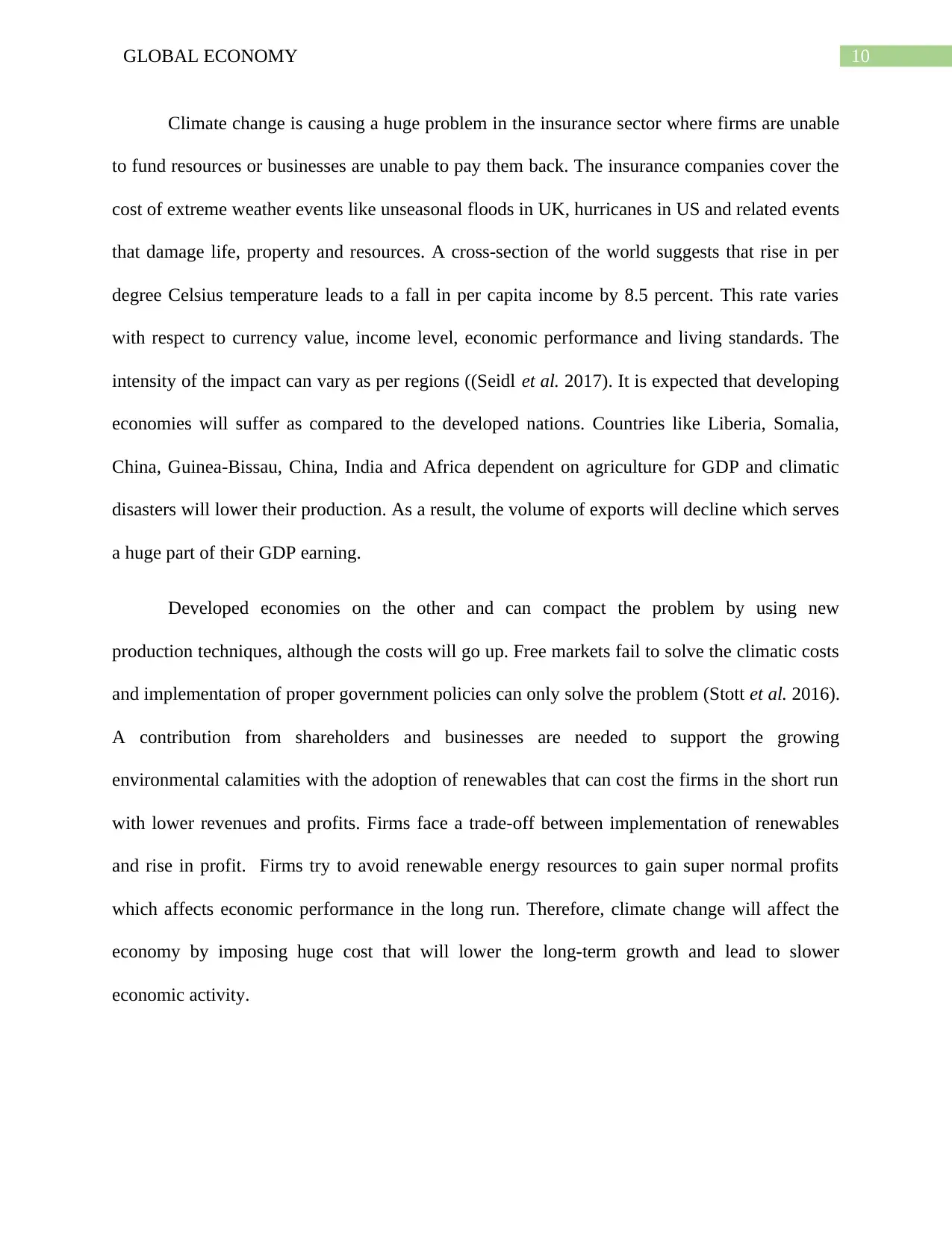
10GLOBAL ECONOMY
Climate change is causing a huge problem in the insurance sector where firms are unable
to fund resources or businesses are unable to pay them back. The insurance companies cover the
cost of extreme weather events like unseasonal floods in UK, hurricanes in US and related events
that damage life, property and resources. A cross-section of the world suggests that rise in per
degree Celsius temperature leads to a fall in per capita income by 8.5 percent. This rate varies
with respect to currency value, income level, economic performance and living standards. The
intensity of the impact can vary as per regions ((Seidl et al. 2017). It is expected that developing
economies will suffer as compared to the developed nations. Countries like Liberia, Somalia,
China, Guinea-Bissau, China, India and Africa dependent on agriculture for GDP and climatic
disasters will lower their production. As a result, the volume of exports will decline which serves
a huge part of their GDP earning.
Developed economies on the other and can compact the problem by using new
production techniques, although the costs will go up. Free markets fail to solve the climatic costs
and implementation of proper government policies can only solve the problem (Stott et al. 2016).
A contribution from shareholders and businesses are needed to support the growing
environmental calamities with the adoption of renewables that can cost the firms in the short run
with lower revenues and profits. Firms face a trade-off between implementation of renewables
and rise in profit. Firms try to avoid renewable energy resources to gain super normal profits
which affects economic performance in the long run. Therefore, climate change will affect the
economy by imposing huge cost that will lower the long-term growth and lead to slower
economic activity.
Climate change is causing a huge problem in the insurance sector where firms are unable
to fund resources or businesses are unable to pay them back. The insurance companies cover the
cost of extreme weather events like unseasonal floods in UK, hurricanes in US and related events
that damage life, property and resources. A cross-section of the world suggests that rise in per
degree Celsius temperature leads to a fall in per capita income by 8.5 percent. This rate varies
with respect to currency value, income level, economic performance and living standards. The
intensity of the impact can vary as per regions ((Seidl et al. 2017). It is expected that developing
economies will suffer as compared to the developed nations. Countries like Liberia, Somalia,
China, Guinea-Bissau, China, India and Africa dependent on agriculture for GDP and climatic
disasters will lower their production. As a result, the volume of exports will decline which serves
a huge part of their GDP earning.
Developed economies on the other and can compact the problem by using new
production techniques, although the costs will go up. Free markets fail to solve the climatic costs
and implementation of proper government policies can only solve the problem (Stott et al. 2016).
A contribution from shareholders and businesses are needed to support the growing
environmental calamities with the adoption of renewables that can cost the firms in the short run
with lower revenues and profits. Firms face a trade-off between implementation of renewables
and rise in profit. Firms try to avoid renewable energy resources to gain super normal profits
which affects economic performance in the long run. Therefore, climate change will affect the
economy by imposing huge cost that will lower the long-term growth and lead to slower
economic activity.
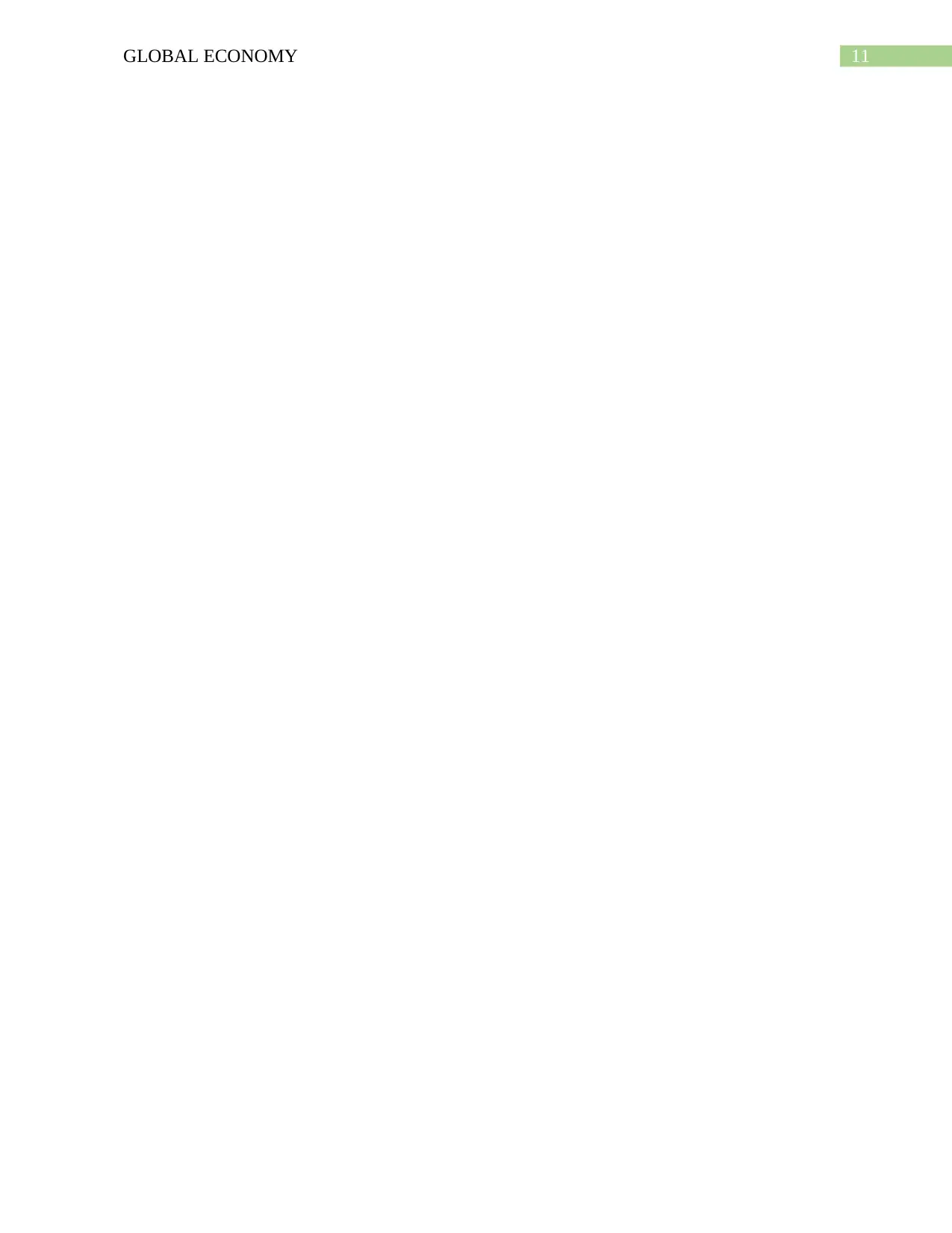
11GLOBAL ECONOMY
⊘ This is a preview!⊘
Do you want full access?
Subscribe today to unlock all pages.

Trusted by 1+ million students worldwide
1 out of 15
Related Documents
Your All-in-One AI-Powered Toolkit for Academic Success.
+13062052269
info@desklib.com
Available 24*7 on WhatsApp / Email
![[object Object]](/_next/static/media/star-bottom.7253800d.svg)
Unlock your academic potential
Copyright © 2020–2025 A2Z Services. All Rights Reserved. Developed and managed by ZUCOL.



